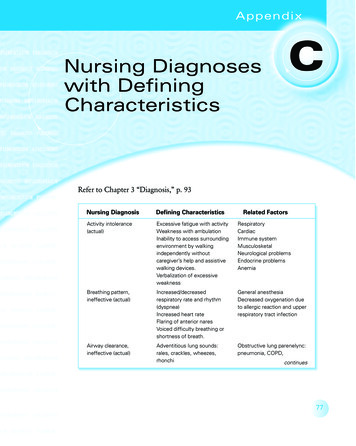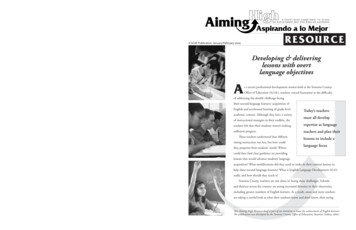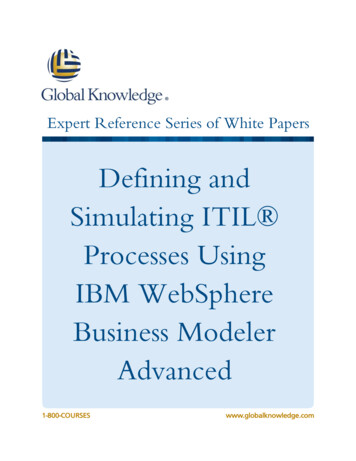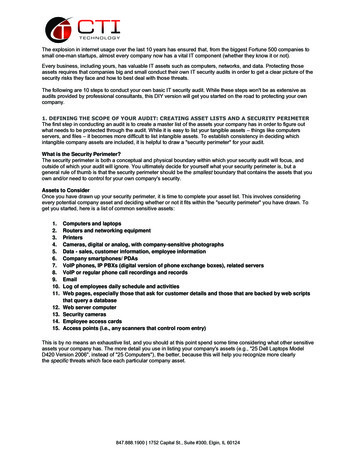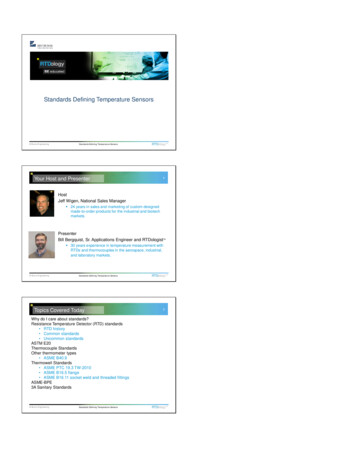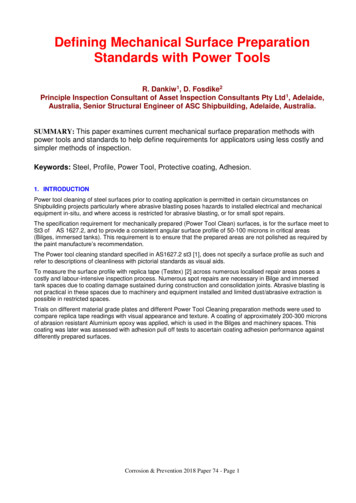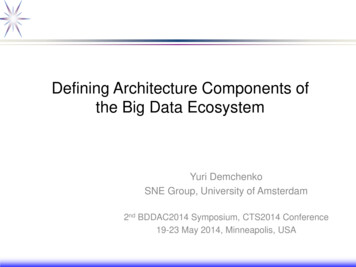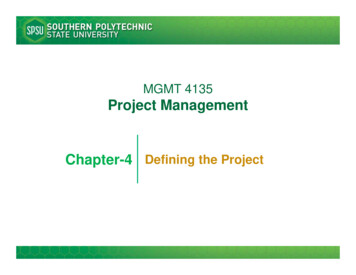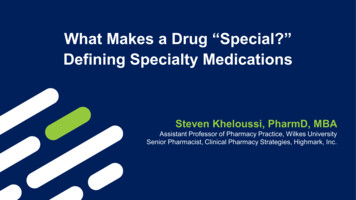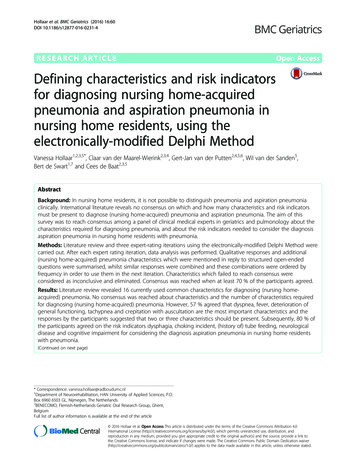
Transcription
Hollaar et al. BMC Geriatrics (2016) 16:60DOI 10.1186/s12877-016-0231-4RESEARCH ARTICLEOpen AccessDefining characteristics and risk indicatorsfor diagnosing nursing home-acquiredpneumonia and aspiration pneumonia innursing home residents, using theelectronically-modified Delphi MethodVanessa Hollaar1,2,3,5*, Claar van der Maarel-Wierink2,3,4, Gert-Jan van der Putten2,4,5,6, Wil van der Sanden5,Bert de Swart1,7 and Cees de Baat2,3,5AbstractBackground: In nursing home residents, it is not possible to distinguish pneumonia and aspiration pneumoniaclinically. International literature reveals no consensus on which and how many characteristics and risk indicatorsmust be present to diagnose (nursing home-acquired) pneumonia and aspiration pneumonia. The aim of thissurvey was to reach consensus among a panel of clinical medical experts in geriatrics and pulmonology about thecharacteristics required for diagnosing pneumonia, and about the risk indicators needed to consider the diagnosisaspiration pneumonia in nursing home residents with pneumonia.Methods: Literature review and three expert-rating iterations using the electronically-modified Delphi Method werecarried out. After each expert rating iteration, data analysis was performed. Qualitative responses and additional(nursing home-acquired) pneumonia characteristics which were mentioned in reply to structured open-endedquestions were summarised, whilst similar responses were combined and these combinations were ordered byfrequency in order to use them in the next iteration. Characteristics which failed to reach consensus wereconsidered as inconclusive and eliminated. Consensus was reached when at least 70 % of the participants agreed.Results: Literature review revealed 16 currently used common characteristics for diagnosing (nursing homeacquired) pneumonia. No consensus was reached about characteristics and the number of characteristics requiredfor diagnosing (nursing home-acquired) pneumonia. However, 57 % agreed that dyspnea, fever, deterioration ofgeneral functioning, tachypnea and crepitation with auscultation are the most important characteristics and theresponses by the participants suggested that two or three characteristics should be present. Subsequently, 80 % ofthe participants agreed on the risk indicators dysphagia, choking incident, (history of) tube feeding, neurologicaldisease and cognitive impairment for considering the diagnosis aspiration pneumonia in nursing home residentswith pneumonia.(Continued on next page)* Correspondence: vanessa.hollaar@radboudumc.nl1Department of Neurorehabilitation, HAN University of Applied Sciences, P.O.Box 6960 6503 GL, Nijmegen, The Netherlands2BENECOMO, Flemish-Netherlands Geriatric Oral Research Group, Ghent,BelgiumFull list of author information is available at the end of the article 2016 Hollaar et al. Open Access This article is distributed under the terms of the Creative Commons Attribution 4.0International License (http://creativecommons.org/licenses/by/4.0/), which permits unrestricted use, distribution, andreproduction in any medium, provided you give appropriate credit to the original author(s) and the source, provide a link tothe Creative Commons license, and indicate if changes were made. The Creative Commons Public Domain Dedication o/1.0/) applies to the data made available in this article, unless otherwise stated.
Hollaar et al. BMC Geriatrics (2016) 16:60Page 2 of 10(Continued from previous page)Conclusions: No final consensus could be reached about which and how many characteristics are required fordiagnosing pneumonia in nursing home residents. However, the results indicated that dyspnea, fever, deteriorationof general functioning, tachypnea and crepitation with auscultation are characteristics of some importance and thatat least two or three characteristics should be present. With regard to considering aspiration pneumonia in nursinghome residents with pneumonia, final consensus was reached about the risk indicators dysphagia, choking incident,(history of) tube feeding, neurological disease and cognitive impairment.Keywords: Nursing home-acquired pneumonia, Aspiration pneumonia, Delphi method, Risk indicator, Characteristic,Nursing homeBackgroundPneumonia is a serious lung infection and can be a lifethreatening disease in nursing home residents [1]. Theincidence of nursing home-acquired pneumonia (NHAP)is tenfold the incidence of community-acquired pneumonia (CAP) [2]. The mortality rate of NHAP is higherthan the mortality rate of CAP, and NHAP is a leadingcause of death in nursing home residents [3–5]. Less differences were found in the aetiology of NHAP and CAP[4, 6]. Streptococcus pneumonia is the most importantpathogen in both pneumonias, whereas Staphylococcusaureus was frequently more present in NHAP than inCAP [4, 7]. Aspiration pneumonia is another specifictype of pneumonia which frequently appears in nursinghome residents due to the inhalation of colonised oropharyngeal material or gastric contents into the larynxand the lower respiratory tract [8].In daily nursing home practice, it is difficult to diagnose (the three types of ) pneumonia because it is notpossible to distinguish the types clinically, and becausespecific markers are not available [9, 10]. Aspirationpneumonia in particular can be difficult to diagnose, because usually the moment of aspiration cannot be observed or the aspiration occurs “silently” [8]. Therefore,chest radiographic examination with fluoroscopy isneeded to confirm the diagnosis of both pneumonia andaspiration pneumonia [8, 11]. However, chest radiographic examinations are seldom possible in nursinghomes. Many nursing home residents suffer from terminal dementia. Consequently, they require appropriatecare for their acute condition and specialized care fortheir chronic conditions. There is strong evidence thatadmission to a hospital results in a higher risk of iatrogenic complications [12, 13]. To prevent these complications, transferring a resident to a hospital to perform achest radiographic is not recommended.Therefore, it is of great concern to recognise characteristics of pneumonia early in order to prevent negativehealth outcomes. An early diagnosis of pneumonia willoptimise the effects of treatment, reduce the complications and even reduce the risk of mortality [14, 15].However, due to the atypical presentation of each typeof pneumonia in nearly all nursing home residents,the (first) characteristics are not clearly recognised byphysicians and nursing staff [1]. Furthermore, it is ofgreat importance to recognise risk indicators whichare involved in the development of the disease. Animportant risk factor of aspiration pneumonia is dysphagia [14, 17–20]. Other identified risk indicatorsare old age, male gender, lung diseases, diabetes mellitus,poor oral health, severe dementia, Parkinson’s disease,malnutrition, and the use of antipsychotic drugs, protonpump inhibitors and angiotensin-converting enzyme inhibitors [17, 21].Up till now, the international literature has not revealedconsensus about which and how many characteristics andrisk indicators must be present in order to diagnose (nursing home-acquired) pneumonia and aspiration pneumonia. The aim of this survey was to reach consensus amonga panel of clinical medical experts in geriatrics and pulmonology about characteristics required for diagnosing pneumonia and about risk indicators needed to consider thediagnosis aspiration pneumonia in nursing home residentswith pneumonia.MethodsSurvey design: electronically-modified Delphi MethodThe electronically-modified Delphi Method was carriedout online among a panel of (highly) qualified clinicalmedical experts in geriatrics and pulmonology in TheNetherlands. Originally, the Delphi Method was developed to predict the impact of technology on warfare[22]. Nowadays, the method has been modified to gatherand structure information on a particular issue fromexperts in an electronical way, using an iterative processto reach consensus on that issue [23, 24]. A panel ofexperts responds to questions anonymously and receivesfeedback by a review of the responses by all panel members involved. This process is repeated until consensus isreached.A heterogeneous panel of 15 to 30 participants and ahomogeneous panel of 10 to 15 participants are deemedsufficient [25, 26]. No generally accepted criteria for selecting experts are available and neither are recommendations
Hollaar et al. BMC Geriatrics (2016) 16:60on the minimal or maximal number of participants [27].The representativeness of the survey seems dependent onthe qualities of the expert panel rather than on the numberof participants [28]. Diversity of experts produces a greatervariety of perspectives on a certain problem, more alternatives and more readily acceptable solutions than those of ahomogeneous group [29, 30]. Advantages of theelectronically-modified Delphi Method are the potential involvement of experts from diverse geographical regionsand the mutual anonymity or faceless acting of the expertpanel. Anonymity minimizes potential group pressure anddominance, as the latter could affect the validity of the outcome negatively [31].Three iterations are usually sufficient to accomplish ahigh level of agreement about a certain issue and haveproven to be sufficient for attaining stability in the responses [23, 31, 32].The current survey was conducted between February2012 and November 2013 in four Phases: a literature review of the currently used characteristics for diagnosing(nursing home-acquired) pneumonia (Phase 1), two general expert-rating iterations (Phase 2 and Phase 3) and aconsensus expert-rating iteration (Phase 4).Expert panelGiven that no recommendations for the number of participants of an expert panel for the electronicallymodified Delphi Method were available, initially as manyas possible clinical medical experts in geriatrics or pulmonology were invited to participate. The medical experts in geriatrics who were selected, were members of anational scientific geriatric medicine association. Theiremail addresses were collected during member meetings.The other selected people were experts in geriatrics andpulmonology, according to a statement on the website ofan (academic) medical centre in The Netherlands. Beforethe members of the expert panel completed the questionnaire, they were informed about this research project. Thisinformation was described in an email message, whichcontained a link to the questionnaire and by completingthe questionnaire written informed consent was given.The survey included an experimental research projectamong medical professionals and was not a medicalresearch experiment among patients. This survey is notdefined in the Netherlands as a medical research experiment, making approval from an ethics committeenot required [33].Data collectionTo perform this survey, the online programme ‘SurveyMonkey’ was used to create and send the questionnairesonline to the expert panel and to gather the questionnaire data. In a previous survey using the electronically-Page 3 of 10modified Delphi Method, this programme had servedappropriately [34].Phase 1The literature was reviewed to search for currently usedcommon characteristics of (nursing home-acquired)pneumonia with the objective to compose a list of characteristics which could be used in Phase 2.Phase 2In the first expert-rating iteration, the selected expertsreceived an invitation to participate by email with ahyperlink to an online questionnaire. After 2 weeks, theexperts received, by email, a reminder in case the questionnaire had not yet been completed.The online questionnaire contained three multiplechoice questions and two structured open-ended questions. The multiple-choice questions were: ‘What is yourmedical specialty?’, ’Which characteristics are the mostimportant when diagnosing (nursing-home acquired)pneumonia?’, and ‘How many characteristics must bepresent for diagnosing (nursing home-acquired) pneumonia?’. With regard to the first question, the list of (nursing home-acquired) pneumonia characteristics derivedfrom the literature review in Phase 1 was submitted, andthe experts were requested to rate 10 characteristics inorder of importance of presence by giving each of the10 characteristics a numerical code from 1 (‘of no importance at all’) to 10 (‘of utmost importance’). The twostructured open-ended questions were: ‘Which characteristics are lacking for diagnosing (nursing homeacquired) pneumonia?’ and ‘Which risk indicators mustbe present in nursing home residents with pneumonia tomake you consider the diagnosis aspiration pneumonia?’.The results were analysed and the list of (nursinghome-acquired) pneumonia characteristics was adjusted accordingly.Phases 3 and 4In the second and third expert-rating iteration, the selected experts received an invitation to participate byemail, with a hyperlink to the adjusted online questionnaire. After 2 weeks, they received, by email, a reminderin case the questionnaire had not yet been completed.Data analysisThe Statistical Package for the Social Sciences (SPSS)20.0 (Chicago, IL, USA) was used for data analysis aftereach expert-rating iteration (Phases 2, 3 and 4). Qualitative responses to structured open-ended questions weresummarized by the first author. Similar responses werecombined and these combinations were ordered by frequency. In order to decide whether additional (nursinghome-acquired) pneumonia characteristics mentioned in
Hollaar et al. BMC Geriatrics (2016) 16:60Page 4 of 10reply to the open-ended question were valuable for usein the next Phase, their frequency was registered. Characteristics which failed to reach consensus were considered as inconclusive and therefore eliminated. In Phases3 and 4, the same procedure as the one that had beenfollowed for the selection of characteristics for diagnosing (nursing home-acquired) pneumonia, was
diagnosis aspiration pneumonia in nursing home residents with pneumonia. Methods Survey design: electronically-modified Delphi Method The electronically-modified Delphi Method was carried out online among a panel of (highly) qualified clinical medical experts in geriatrics and pulmonology in The Netherlands. Originally, the Delphi Method was devel- oped to predict the impact of technology on .

